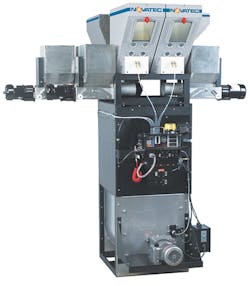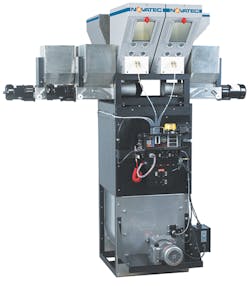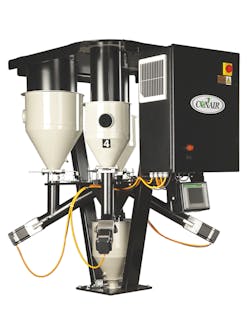Special Report: Blender technology opening new markets for processors
As resin formulas steadily become more complex, and the types and forms of the components multiply, blender technology is becoming more critical. Plastics Machinery Magazine checked in with a couple of leading suppliers and the good news is they are not just keeping up. Instead, they are leading the charge, with 12,000 pounds per hour — and better — throughput and eye-dropper dosing where needed. Increasingly, both of those advancements, and more, are needed in the same blender.
BLENDER CONCEPT
CAPTURES EMERGING APPLICATIONS
Maguire Products Inc., Aston, Pa., shipped its first gravimetric blender in 1989 and soon will ship its 50,000th. Those blenders are located in plastics processing shops around the world, as well as in material supplier and compounder facilities. However, were the first one and No. 50,000 mounted on adjacent molding machines, the family resemblance would not just be obvious, it would be striking — first cousins at least but more probably siblings.
Pat Smith, VP at Maguire, says the similarity results from the original design being modular, and therefore flexible and adaptable. It's also, says Smith, because the engineering mantra of form follows function is one that still guides company founder Steve Maguire. Smith says, "Everything about our design is for a purpose, and none of it is for being pretty." Apparently one of those purposes is to expand the business into new applications and new markets, and the original modular design has adapted to those well.
The Maguire blender also is supplied by Novatec Inc., Baltimore, in which Steve Maguire holds a majority stake. It arrives with the capability to process 12 components standard, not only in the hardware, but also, and equally important, in the software. Most processors won't be using 12, but Smith says many already are. Many of the newer applications have nine, 10 and 11 components, and many of them are powder, which has always posed a challenge. In 2005, Maguire developed a high-volume blender for a nine-component wood-composite application that also required specific dispensing devices for wood flour, high-volume but poorly flowing powder, poorly flowing regrind, micro-dosing of pellets and powder and liquid dosing.
That blender later launched as Maguire's MaxiBatch line, which now provides throughputs exceeding 10,000 pounds per hour with powder as a major component. All the specialized dispensing devices are in-stock and available with quick delivery times, tailored as customers order them. For Maguire, MaxiBatch opened the door to material suppliers and compounders that need multi-component, high-throughput and powder-capable blenders. It also opened the door to several new markets and applications.
Smith says the wood composite sector has grown, and the blender's ability to handle the almost-light-as-air wood flour, along with multiple other powders and liquids, at high throughput levels matches what's needed. Another example of a new market for Maguire is solar film. Competition has driven producers to develop films that provide higher solar collection efficiency. That has resulted in films with as many as 11 components in a variety of forms.
Recyclers, says Smith, are another growth market for multi-component, high-volume blending. They are using blowing agents, compatibilizers and many other components in their processing, and they need highly accurate blending to deliver homogeneous blends. The primary challenge to maintaining accuracy in gravimetric blending is vibration, says Smith. Maguire's patented methods of load cell verification involve taking two verification readings that can be compared and used to eliminate the effect of vibration. The standard blender provides accuracy to within 0.1 percent of the setpoint.
Maguire is aiming its technology at many parts of the plastics processing spectrum besides the high-volume sector. It says that its WSB-MB MicroBlender is the world's smallest weigh-scale blender, and makes the benefits of gravimetric blending available and affordable for processors running small machines. It blends as many as four components at 140 pounds per hour and includes MicroPulse technology, which eliminates the need for augers to achieve accurate dispensing of minor ingredients. MicroPulse will dispense as few as two or three pellets per pulse cycle. The system is fully pneumatic and less than 2 feet high, has no motors, weighs only 50 pounds and delivers batch accuracy to within 0.1 percent.
Smith says other blender suppliers compete against Maguire based on its utilitarian design, offering sleek enclosures. The enclosures come at a cost, though, according to Maguire. Enclosed blenders are generally limited to six components. Smith says the enclosures also keep dust from escaping and trap heat. When confined dust accumulates, it can interfere with internal components and the load cell or cells, which can simply stop working. Trapped heat can also affect load cell operation, and when auxiliary cooling is added, the trapped dust can interfere. Smith says, "All that just reminds us that form really should follow function."
CONAIR
The Conair Group, Cranberry Township, Pa., is focused on four key blending issues facing processors. They include handling difficult materials without repelletizing, achieving greater accuracy, making color changes more quickly and tracking the materials used.
Alan Landers, Conair's blending product manager, begins with handling difficult-to-feed materials, noting that processors are using more post-industrial and post-consumer scrap. Some of the scrap, like bottle and sheet flake, has relatively large, flat surfaces, which tend to pack together and bridge in conventional hoppers. Processors have had to re-pelletize these materials for efficient handling in standard blenders and feeders, which was less economical. Landers says Conair takes several approaches to handling these materials without repelletizing. The approaches take advantage of several innovations:
• Regardless of what other flow-enhancing mechanisms are used, steep-sided material bins change the angle of repose of the flakes or granules and enhance the effect of gravity on material flow.
• A lift auger at an angle in a corner of the regrind bin won't force material out of the bin, but moves granules away from the bottom, fluidizing the material to flow more easily through oversized side gates into the mixing chamber.
• A horizontal dosing auger doses difficult materials. (It's more effective in small-volume blenders.)
• A continuous gravimetric blender can feed up to six ingredients simultaneously. That's unlike batch gravimetric blenders that dispense ingredients one at a time into a weigh bin, then drop them into a mixer. This makes the continuous gravimetric blender an excellent option with materials of different particle sizes and widely varying bulk densities. In a Conair continuous blender, each bin includes a TrueWeigh gravimetric hopper and an inclined auger. Auger size and rotation speed determine how fast material is dispensed, but the amount dispensed is governed by loss-in-weight measured by the TrueWeigh hopper. Even doses as low as 4 ounces per hour can be metered within half a percent of setpoint, depending on the material. This "cascade" mixing technology results in a more homogeneous blend than batch blending. Landers says if just a few pellets of color or additive are supposed to be in a pound of virgin, that's exactly what you get.
Next on the list is greater accuracy, increasingly important as material blends become more complex. Material blends often involve extremely small amounts of very expensive additives. The key to accurate dispensing lies in correctly sizing the metering valve openings. Small openings are required to ensure accurate dispensing of extremely low dosing percentages, while large valve openings are required to achieve high dosing percentages at the desired rate of the process. A small dosing valve for a high-percentage component will dose accurately, but will limit the total rate for the blender. On the other hand, a large dosing valve will compromise dosing accuracy in recipes that call for a small-percentage ingredient.
Landers offers a couple of ways processors can make faster color changes without sacrificing productivity:
• Rapid cleanout, he says, is the simplest way to ensure a quick recipe change. To make cleaning hoppers, weigh bins and mixing sections as easy as possible, Conair recently redesigned the metering/mixing sections of its small and mid-size TrueBlend blenders. The front and back of the mixer now are continuously welded to limit the chance that dust can accumulate in the seams between surfaces. The agitator and the mixing body are now one assembly. The entire unit can be removed — without tools — then emptied and cleaned using a compressed air nozzle supplied with the blender. Reinstalling the mixer is simpler, too. A keyway in the mixer exit gate ensures the mixer is properly positioned.
• Staging colors in multiple hoppers is another way to speed color changes. Conair supplies blenders with up to 12 material hoppers, so processors can stage various colors. A simple recipe change (multiple recipes can be stored in the control for easy recall) is all it takes to switch colors. Sequencing the color recipes from light to dark can reduce the amount of purge time between colors.
Tracking materials use, the fourth item on Landers' list, shows off a recent Conair innovation. Processors can now store all data from all Conair blenders in one database. This allows them to track how much resin, regrind, color and additives are being processed. Each TrueBlend SB2 touch-panel control (Version 1.08.0 and newer) can communicate directly with a computer hard drive using software and a standard network. When the control is first connected with the new database, it automatically creates all required data tables and data relationships. Then, as the blender operates, it automatically adds data to the database.
Database system users can write their own queries to generate the desired report or use standard query templates developed by Conair.
Rob Neilley, senior correspondent
Contact:
Conair Group, 724-584-5500, www.conairgroup.com
Maguire Products Inc., 610-459-4300, www.maguire.com
Novatec Inc., 410-789-4811, www.novatec.com


